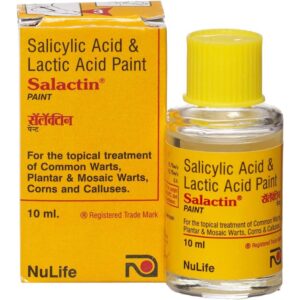LACTIC ACID + SALICYLIC ACID
Lactic Acid: Lactic Acid is not a drug per se, but rather an organic compound produced in the body during intense exercise or as a result of certain medical conditions. It is a byproduct of anaerobic metabolism, where glucose is broken down without the presence of oxygen in the muscles. Therefore, it is not typically administered as a medication, but rather measured as a marker of metabolic activity.
Use:
Lactic Acid measurements are commonly used in healthcare settings to diagnose conditions such as lactic acidosis, which occurs when there is an excessive buildup of lactic acid in the blood. Lactic Acid levels may be monitored in individuals undergoing intense exercise or in those with certain medical conditions such as sepsis, liver disease, or respiratory distress.
Mechanism of Action:
As previously mentioned, lactic acid is produced as a result of anaerobic metabolism. During intense exercise or in certain medical conditions, the body cannot provide enough oxygen to meet the demands of the muscles. Consequently, glucose is broken down through a process called glycolysis, leading to the production of lactic acid.
Dose:
Since lactic acid is a metabolic byproduct, it is not administered in specific doses as a medication. Rather, it is measured in blood samples using a lactate test. The reference range for blood lactate levels varies depending on the lab, but usually falls between 0.5-2.2 mmol/L in a resting state.
Side Effects:
Elevated lactic acid levels in the blood, known as lactic acidosis, can cause symptoms such as nausea, vomiting, abdominal pain, muscle weakness, rapid breathing, and confusion. It can be a life-threatening condition and requires immediate medical attention. However, it is important to note that lactic acid itself is not a medication and does not have specific side effects when measured within normal ranges.
Salicylic Acid: Salicylic acid is a medication commonly used as a topical treatment for various skin conditions, including acne, psoriasis, and warts. It belongs to the class of medications known as keratolytics, which work by exfoliating and removing dead skin cells, thus unclogging pores and preventing the formation of new acne lesions.
When applied topically, salicylic acid softens and loosens the outer layer of the skin, promoting shedding of dead skin cells and increasing cell turnover. This leads to the removal of blackheads and whiteheads and helps to unclog pores. Salicylic acid also has anti-inflammatory properties, which can help reduce redness and swelling associated with acne.
The concentration and formulation of salicylic acid may vary depending on the condition being treated. For acne, it is typically available as a gel, lotion, or cream, with concentrations ranging from 0.5% to 2%. It is usually applied to the affected area once or twice daily.
Common side effects of salicylic acid include skin irritation, redness, and dryness. Some individuals may experience mild stinging or burning upon application. Higher concentrations or frequent and prolonged use may increase the risk of more severe side effects such as blistering, peeling, or skin discoloration. It is important to follow the instructions provided by a healthcare professional or on the product label and to avoid applying salicylic acid to broken or irritated skin.
Salicylic acid should not be used by individuals who are allergic to salicylates or have a known sensitivity to the medication. It should also be used with caution in individuals with kidney disease, as excessive absorption of salicylic acid through the skin could lead to systemic effects. Pregnant or breastfeeding women should consult with their healthcare provider before using salicylic acid.
Overall, salicylic acid is an effective topical treatment for various skin conditions. However, it is always advisable to consult with a healthcare professional to determine the appropriate concentration, formulation, and frequency of use based on individual needs and skin sensitivity.

